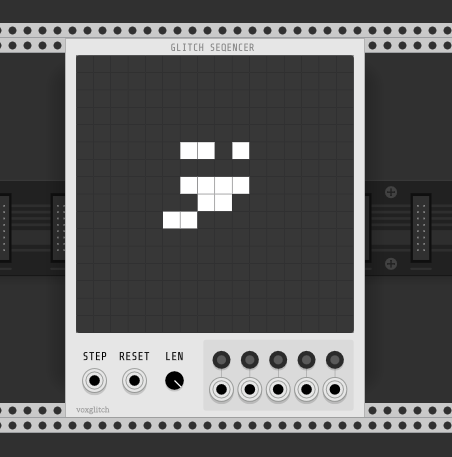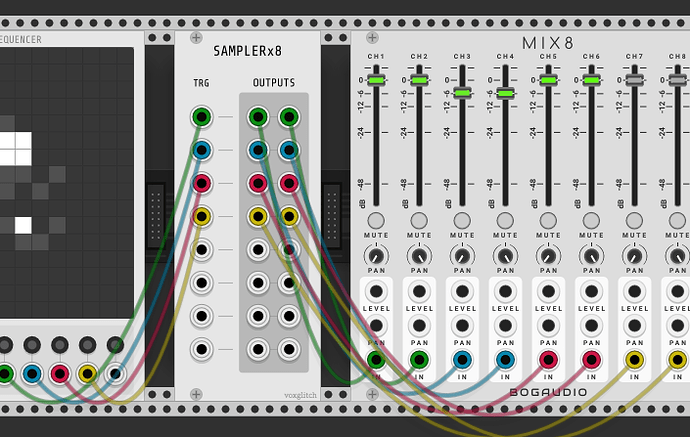Glitch Sequencer is functional! If you are a brave early adopter, please have at it! Here’s a build for windows:
You can also find it on github here: https://github.com/clone45/voxglitch/tree/glitchsequencer

Brief Instructions
Getting started
At the bare minimum, attach a clock signal to the STEP input as you would any other sequencer. Connect the gate outputs to whatever you like, such as drum modules. Done!
Editing the ‘Seed Pattern’
This sequencer is based on Conway’s Game of Life. The starting pattern (which I call the seed pattern) evolves over time, then restarts at the end of the sequence. The playback length is controlled by the LEN knob. Glitch Sequencer functions very much like any other sequencer in respect to STEP, RESET, and LEN inputs.
Editing the seed sequence is easy: Simply draw on the grid. You’ll notice that when you mouse-over the grid, you’re shown the seed pattern for editing. When you mouse out, you see the pattern being played back.
Editing the trigger points
There are five trigger outputs. A trigger output generates a pulse whenever the playback sequence lands on a trigger point. Think of it like the vintage game “Battleship”: If one of the trigger points is “hit”, it generates a pulse on the output.
The module comes with some trigger points preset to make it easy for beginners. To edit trigger points, click on one of the 5 buttons above the trigger outputs, then click on the grid to place or remove trigger points. Each gate output can have multiple trigger points. The trigger points are not shared between outputs.
To return back to editing the seed pattern, deselect the active trigger button. << IMPORTANT
I haven’t written formal documentation for this yet. I hope that’s enough to get you started! My next goal is to update my documentation and make a demo video for Glitch Sequencer.
Features coming soon:
- Ability to clear patterns
- Possibly an optional blue theme to match Digital Sequencer’s color scheme
- Shift patterns around using the arrow keys
Enjoy! I’ll get this submitted to the user library in a few days.
 : Could you make the Grain Engine module follow 1 v/oct for melodic pitch control? And with interpolation (smoothing/anti-aliasing for pitched sample playback) please
: Could you make the Grain Engine module follow 1 v/oct for melodic pitch control? And with interpolation (smoothing/anti-aliasing for pitched sample playback) please 
 , but anything in this direction will be fine
, but anything in this direction will be fine





